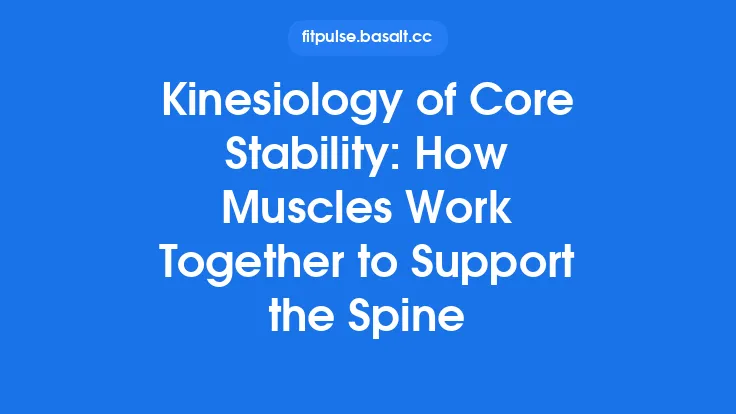The human musculoskeletal system is constantly challenged by the forces generated during exercise. While strength and conditioning programs aim to increase muscular capacity, the way those forces are transmitted through bones, cartilage, ligaments, and tendons determines whether the training stimulus remains beneficial or becomes a source of joint overload. By understanding how load is distributed across joint structures and by fine‑tuning exercise technique, athletes and clinicians can markedly reduce joint stress, prolong the functional lifespan of connective tissues, and maintain consistent performance gains.
Understanding Load Distribution in Musculoskeletal Structures
Load transmission pathways
When a muscle contracts, it pulls on its tendon, which in turn applies a force to the bone at the insertion site. This force is not isolated; it travels through the joint’s articular surfaces, the surrounding capsule, ligaments, and the peri‑articular musculature. The distribution of this force depends on three primary variables:
- Magnitude of the external load – the weight of the barbell, dumbbell, or resistance band.
- Direction of the force vector – the line of action relative to the joint’s anatomical planes.
- Contact area of the joint surfaces – larger contact areas disperse stress more effectively than focal points.
Stress vs. strain
Stress (force per unit area) is the mechanical quantity that directly influences cartilage health. High compressive stress can accelerate cartilage wear, while excessive shear stress may strain the menisci or labrum. Strain, the deformation of tissue relative to its original length, is more closely linked to the viscoelastic properties of ligaments and tendons. Optimizing technique aims to keep both stress and strain within physiologically tolerable limits.
Joint reaction forces
Every movement generates a joint reaction force (JRF) – the net force the joint must counteract to maintain stability. JRF magnitude can be several times body weight, especially in weight‑bearing exercises such as squats or deadlifts. The orientation of the JRF relative to the joint’s articular surfaces dictates whether the load is primarily compressive (generally safer for cartilage) or includes a substantial shear component (potentially harmful).
Key Factors Influencing Joint Stress During Exercise
| Factor | How It Affects Load Distribution | Practical Implication |
|---|---|---|
| Joint angle at the point of load | Alters the moment arm of the muscle‑tendon unit, shifting the line of action of the force. | Maintaining mid‑range joint angles often reduces peak compressive stress. |
| Speed of movement | Faster contractions increase inertial forces, adding to the JRF. | Controlled tempo mitigates sudden spikes in joint loading. |
| Foot/hand placement | Determines the base of support and influences the direction of the ground reaction force (GRF). | Aligning the GRF through the joint’s center reduces eccentric shear. |
| Bar path (or equipment trajectory) | A non‑vertical bar path can introduce unwanted anterior‑posterior shear. | Keeping the bar close to the body’s center of mass aligns forces more vertically. |
| Muscle activation patterns | Inadequate co‑contraction of stabilizing muscles leads to uneven load sharing. | Emphasizing neuromuscular activation of antagonists (e.g., hamstrings during knee extension) balances joint forces. |
| Fatigue | Reduces proprioceptive acuity and alters motor patterns, increasing off‑axis loading. | Monitoring fatigue and adjusting volume/intensity preserves technique integrity. |
Technique Modifications to Optimize Load Path
1. Squat Variations
- Depth control – Descending to a depth where the hip crease is just below the top of the knee (often termed “parallel”) keeps the tibio‑femoral joint within a range where the compressive surface area is maximized, reducing peak cartilage stress.
- Knee tracking – Ensuring the knees track in line with the toes prevents excessive valgus moments that concentrate load on the lateral compartment.
- Bar placement – A high‑bar (resting on the trapezius) aligns the load more directly over the mid‑foot, whereas a low‑bar shifts the center of mass posteriorly, increasing hip extension moments but also raising shear at the lumbar spine. Selecting the bar position based on individual mobility and joint health is essential.
2. Deadlift Mechanics
- Hip hinge emphasis – Initiating the lift with a hip hinge rather than a knee‑dominant motion moves the load line closer to the hip joint’s center, decreasing shear at the lumbar vertebrae and knee.
- Grip width – A narrower grip reduces the moment arm at the shoulder, limiting excessive anterior shear on the glenohumeral joint.
- Foot stance – A stance that aligns the GRF through the mid‑foot ensures the lumbar spine experiences primarily compressive forces.
3. Pressing Movements (Bench, Overhead)
- Scapular positioning – Retraction and depression of the scapula create a stable platform, distributing the load across the thoracic spine and reducing shear at the glenohumeral joint.
- Elbow angle – Maintaining an elbow angle of approximately 45–60° from the torso during the bench press reduces peak anterior shear on the shoulder capsule.
- Bar path – A slightly arced bar path that follows the natural curvature of the shoulder joint (from lower chest to upper chest) keeps the line of force within the joint’s safe zone.
4. Lower‑Body Isolation (Leg Press, Leg Extension)
- Seat angle – Adjusting the seat to keep the hips and knees at roughly 90° during the press aligns the force vector through the joint’s center, minimizing shear.
- Range of motion – Avoiding full hyperextension at the knee prevents excessive compressive stress on the posterior tibial plateau.
Equipment and Environmental Considerations
Load‑bearing surfaces
Hard surfaces (concrete) transmit higher impact forces compared to compliant platforms (rubber mats). For high‑impact lifts (e.g., Olympic lifts), a slightly cushioned surface can attenuate peak JRF without compromising stability.
Footwear
Shoes with a stable, low‑profile sole maintain a consistent foot‑ground interface, preserving the intended GRF direction. Excessive heel height or overly soft midsoles can shift the center of pressure anteriorly, increasing knee shear.
Resistance modality
Free weights allow for natural load paths but demand higher neuromuscular control. Machines constrain the trajectory, often reducing off‑axis shear but potentially limiting functional transfer. Selecting the modality based on the athlete’s skill level and joint health is crucial.
Assistive devices
Wrist wraps, knee sleeves, and lumbar belts can augment joint stability, allowing the practitioner to maintain optimal technique under heavier loads. However, reliance on these devices should be balanced with progressive strengthening of the underlying stabilizers.
Monitoring and Adjusting Load Over Time
- Quantitative tracking
- Repetition velocity: Declines in bar speed at a given load can signal early fatigue, prompting technique checks.
- Force plate data: Center‑of‑pressure shifts reveal asymmetries that may increase joint stress.
- Qualitative assessment
- Video analysis: Slow‑motion playback helps identify subtle deviations in bar path or joint alignment.
- Palpation and joint range checks: Regular mobility screens detect emerging restrictions that could alter load distribution.
- Progressive overload strategy
- Micro‑loading: Adding 0.5–1 kg increments allows the neuromuscular system to adapt without abrupt changes in joint loading.
- Deload weeks: Scheduled reductions in volume/intensity give connective tissues time to remodel and recover.
- Periodization for joint health
- Undulating models: Alternating high‑load, low‑rep phases with moderate‑load, higher‑rep phases distributes stress across different tissue types (tendons vs. cartilage).
- Recovery emphasis: Incorporating active recovery sessions (e.g., low‑impact cycling) maintains circulation to joint tissues, supporting nutrient delivery and waste removal.
Practical Guidelines for Common Exercises
| Exercise | Key Technique Cue for Load Distribution | Joint Stress Mitigation |
|---|---|---|
| Back Squat | “Sit back as if sitting into a chair; keep knees tracking over toes.” | Reduces anterior knee shear; maximizes femoral‑tibial contact area. |
| Front Squat | “Maintain elbows high; keep torso upright.” | Shifts load anteriorly, decreasing lumbar compressive forces. |
| Romanian Deadlift | “Hinge at hips, keep shins vertical, slight knee bend.” | Keeps load centered over hips, limiting lumbar shear. |
| Bench Press | “Retract scapula, lower bar to mid‑chest, elbows at 45°.” | Aligns force through shoulder joint’s safe zone, reduces anterior capsule strain. |
| Overhead Press | “Press in a straight line, keep head neutral, engage core.” | Maintains vertical load path, minimizing shoulder shear. |
| Leg Press | “Feet hip‑width, press through heels, stop before full knee extension.” | Distributes load evenly across tibio‑femoral joint, avoids hyperextension stress. |
| Cable Row | “Pull elbows back, keep shoulders down, maintain a neutral spine.” | Centers load on the scapulothoracic joint, reducing excessive cervical shear. |
Integrating Load Distribution Principles into Training Programs
- Assessment phase
Conduct a baseline biomechanical screen focusing on joint alignment, mobility, and muscle activation patterns. Identify any asymmetries that could predispose an athlete to uneven load distribution.
- Program design
- Exercise selection: Prioritize multi‑joint movements that naturally align the load path (e.g., squat, deadlift) before adding isolation work.
- Volume allocation: Distribute total weekly load across multiple sessions to avoid excessive cumulative joint stress in a single workout.
- Technique drills: Include low‑load, high‑repetition sessions dedicated to perfecting bar path and joint alignment.
- Feedback loops
Use wearable inertial sensors or video analysis to provide immediate feedback on technique deviations. Encourage athletes to self‑monitor cues (e.g., “Is my knee tracking?”) during sets.
- Recovery integration
Schedule mobility work (dynamic stretching, foam rolling) and low‑impact cardio to promote synovial fluid circulation, which aids cartilage nutrition and reduces joint stiffness.
- Long‑term progression
Re‑evaluate joint health every 8–12 weeks. Adjust load distribution strategies based on observed adaptations, ensuring that increases in strength are matched by improvements in joint loading efficiency.
Future Directions and Research Opportunities
- Computational modeling: Advances in finite element analysis (FEA) allow for subject‑specific simulations of joint stress under various technique modifications. Integrating these models into coaching platforms could provide real‑time predictions of cartilage loading.
- Wearable biomechanics: Next‑generation inertial measurement units (IMUs) combined with machine‑learning algorithms can detect subtle deviations in load path, offering early warnings before joint stress becomes problematic.
- Nutritional synergy: Investigating how targeted nutrients (e.g., collagen peptides, omega‑3 fatty acids) interact with optimized load distribution to enhance cartilage resilience.
- Aging populations: Tailoring load distribution strategies for older adults to preserve joint health while still achieving strength gains, potentially reducing the incidence of osteoarthritis.
By systematically examining how forces travel through the musculoskeletal system and by applying precise technique adjustments, practitioners can dramatically reduce joint stress without compromising training effectiveness. The science of load distribution is a cornerstone of sustainable, injury‑free performance—an evergreen principle that remains relevant across all levels of athletic endeavor.





